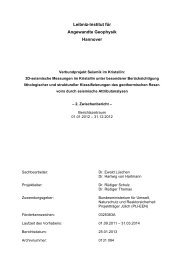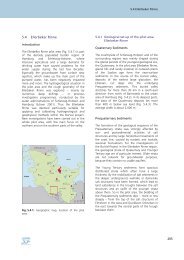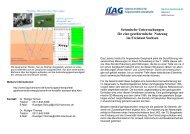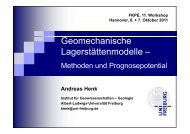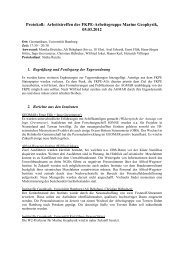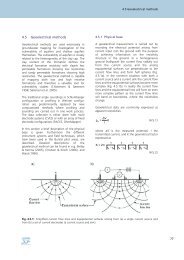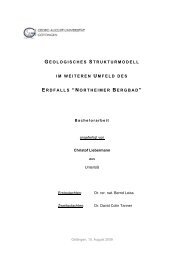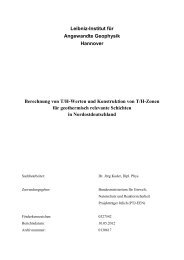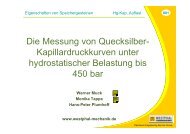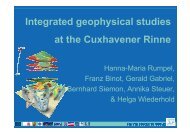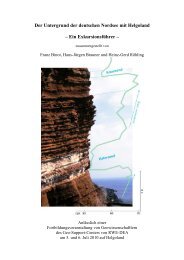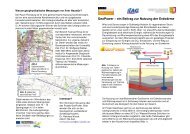Magnetic Resonance in the Subsurface – 5th International ... - LIAG
Magnetic Resonance in the Subsurface – 5th International ... - LIAG
Magnetic Resonance in the Subsurface – 5th International ... - LIAG
You also want an ePaper? Increase the reach of your titles
YUMPU automatically turns print PDFs into web optimized ePapers that Google loves.
Recent advancements <strong>in</strong> NMR for characteriz<strong>in</strong>g <strong>the</strong> vadose zone 50<br />
Recent advancements <strong>in</strong> NMR for characteriz<strong>in</strong>g <strong>the</strong> vadose zone<br />
David Walsh 1 , Elliot Grunewald 1 , Hong Zhang 1 , Paul Ferre 2 and Andrew H<strong>in</strong>nell 2<br />
1 Vista Clara, Inc., Mukilteo, WA, USA, davewalsh@vista-clara.com, 2 University of Arizona, Tucson AZ, USA<br />
Until recently, most applications of NMR<br />
<strong>in</strong> hydrogeology have focused on detect<strong>in</strong>g<br />
and characteriz<strong>in</strong>g groundwater <strong>in</strong> <strong>the</strong><br />
saturated zone. Ano<strong>the</strong>r target for<br />
hydrogeophysical methods is water <strong>in</strong> <strong>the</strong><br />
vadose zone, <strong>the</strong> dynamics of which<br />
control contam<strong>in</strong>ant migration,<br />
groundwater recharge, evapotranspiration,<br />
and soil stability. The challenge of<br />
characteriz<strong>in</strong>g water <strong>in</strong> <strong>the</strong> vadose zone by<br />
NMR is that <strong>the</strong> signals are typically very<br />
weak (due to low water content) and very<br />
short (due to concentration of water on<br />
gra<strong>in</strong> surfaces or <strong>in</strong> <strong>the</strong> smallest available<br />
pores). Here we present improvements <strong>in</strong><br />
NMR geophysics technology over <strong>the</strong> past<br />
4 years, and demonstrate <strong>the</strong> application of<br />
<strong>the</strong>se technologies to vadose zone<br />
characterization.<br />
To address <strong>the</strong> challenges of us<strong>in</strong>g Earth’s<br />
field surface NMR <strong>in</strong>strumentation to<br />
detect and characterize water <strong>in</strong> <strong>the</strong> vadose<br />
zone, we designed a modified GMR<br />
<strong>in</strong>strument with faster switch<strong>in</strong>g and higher<br />
powered electronics. This <strong>in</strong>strument has a<br />
measurement dead-time of 2.8 ms, an<br />
<strong>in</strong>stantaneous power output of 7000 V and<br />
800 A, and a noise floor of 0.5 nV/rt(Hz).<br />
The new <strong>in</strong>strument was used to collect<br />
and <strong>in</strong>terpret surface NMR data at active<br />
vadose zone <strong>in</strong>vestigation sites <strong>in</strong> <strong>the</strong><br />
western United States. First, <strong>the</strong> equipment<br />
was used to detect, image and quantify<br />
water <strong>in</strong>filtrat<strong>in</strong>g <strong>in</strong>to <strong>the</strong> ground at a<br />
managed aquifer storage and recovery<br />
(ASR) facility <strong>in</strong> Tucson Arizona. Analysis<br />
of this data <strong>in</strong>dicates that <strong>the</strong> surface NMR<br />
tool was able to measure <strong>the</strong> recharge<br />
speed of <strong>the</strong> <strong>in</strong>itial wett<strong>in</strong>g front, and<br />
quantify some, but not all of <strong>the</strong> water that<br />
was recharged. Fur<strong>the</strong>r analysis showed<br />
that <strong>in</strong>filtrat<strong>in</strong>g water filled larger pores,<br />
temporarily, and <strong>the</strong> water filled pore size<br />
distribution <strong>in</strong> <strong>the</strong> top 15m returned to its<br />
“dry“ condition with<strong>in</strong> 3 weeks of <strong>the</strong> end<br />
of <strong>the</strong> surface water <strong>in</strong>filtration.<br />
Additional surface NMR measurements at<br />
vadose zone <strong>in</strong>vestigations <strong>in</strong> Wash<strong>in</strong>gton,<br />
Nebraska and Kansas demonstrated that<br />
<strong>the</strong> equipment could detect and image <strong>the</strong><br />
location of bound and perched water to<br />
depths of at least 25m. Borehole NMR logs<br />
at <strong>the</strong>se sites <strong>in</strong>dicated that <strong>the</strong> surface<br />
NMR measurements were detect<strong>in</strong>g only a<br />
portion of <strong>the</strong> bound water. Additional<br />
borehole NMR measurements <strong>in</strong> eastern<br />
Kansas demonstrated <strong>the</strong> ability of NMR<br />
logg<strong>in</strong>g to detect and quantify transient<br />
water content <strong>in</strong> <strong>the</strong> vadose zone. In this<br />
case decayed tree roots were temporarily<br />
saturated with water, follow<strong>in</strong>g a local<br />
stream flood event.<br />
F<strong>in</strong>ally, a new geotechnical NMR<br />
<strong>in</strong>strument has been developed and<br />
demonstrated for detect<strong>in</strong>g and<br />
characteriz<strong>in</strong>g soil moisture <strong>in</strong> <strong>the</strong> top 1m<br />
of <strong>the</strong> subsurface. This tool generates a<br />
boosted static gradient field, and performs<br />
non-<strong>in</strong>vasive CPMG NMR measurements<br />
<strong>in</strong> <strong>the</strong> low RF band (40 kHz <strong>–</strong> 500 kHz)<br />
with an echo spac<strong>in</strong>g of 1 ms or less.<br />
Prelim<strong>in</strong>ary field tests showed that <strong>the</strong> tool<br />
can accurately measure water content and<br />
its T2 distribution at multiple depths, <strong>in</strong><br />
both dry and wetted conditions, with total<br />
scan times of approximately 3 m<strong>in</strong>utes.<br />
Acknowledgement: This material is based upon<br />
work supported, <strong>in</strong> part, by <strong>the</strong> US Department of<br />
Energy under Grant numbers DE-FG02-<br />
08ER84979 and DE-SC000423, and US Army<br />
Contract # W912HZ-12-P-0018. Any op<strong>in</strong>ions,<br />
f<strong>in</strong>d<strong>in</strong>gs, and conclusions or recommendations<br />
expressed <strong>in</strong> this material are those of <strong>the</strong> author(s)<br />
and do not necessarily reflect <strong>the</strong> views of <strong>the</strong> US<br />
Department of Energy or <strong>the</strong> US Army.<br />
<strong>Magnetic</strong> <strong>Resonance</strong> <strong>in</strong> <strong>the</strong> <strong>Subsurface</strong> <strong>–</strong> 5 th <strong>International</strong> Workshop on <strong>Magnetic</strong> <strong>Resonance</strong><br />
Hannover, Germany, 25 <strong>–</strong> 27 September 2012



